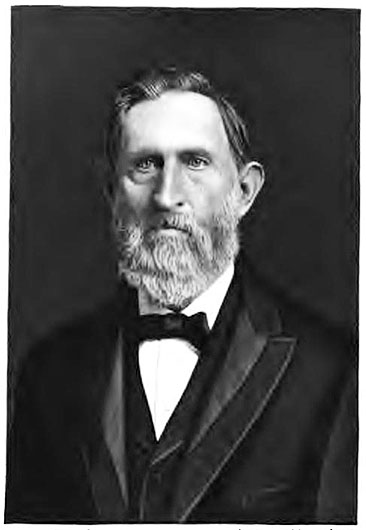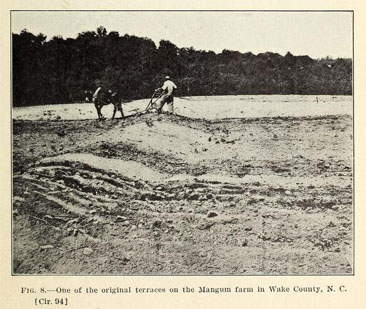Mangum, Priestley Hinton, Jr.
21 Aug. 1829–26 Feb. 1907
See also: Mangum Terrace
 Priestley Hinton Mangum, Jr., farmer and agricultural promoter, was born in Wake County, the son of Priestley Hinton and Rebecca Hilliard Sutherland Mangum. He was the brother of Willie P. Mangum, Jr., and the nephew of Willie Person Mangum. Priestley Hinton, Jr., attended the Bingham School in Orange County and was graduated from Wake Forest College in 1851. For the remainder of his life he was a farmer in northern Wake County.
Priestley Hinton Mangum, Jr., farmer and agricultural promoter, was born in Wake County, the son of Priestley Hinton and Rebecca Hilliard Sutherland Mangum. He was the brother of Willie P. Mangum, Jr., and the nephew of Willie Person Mangum. Priestley Hinton, Jr., attended the Bingham School in Orange County and was graduated from Wake Forest College in 1851. For the remainder of his life he was a farmer in northern Wake County.
As a farmer Mangum was a student and an advocate of progressive agricultural techniques. In particular, he found success in the practice of and fame in the promotion of terracing as a form of erosion control. In 1885, on his farm two miles west of Wake Forest, Mangum constructed the first examples of what became known as the "Mangum terrace." Two factors had pushed him to this development. The first was the wasted land necessary for the ditches then used in the southern Piedmont to control water runoff from farmlands. The second was the advent of farm machinery that could not be used efficiently on ditched land. Consequently, Mangum constructed his "terraces" as  broad ridges with a gentle slope that would break the flow of water yet permit the growth of crops and be accessible to machinery.
broad ridges with a gentle slope that would break the flow of water yet permit the growth of crops and be accessible to machinery.
Initially, the news of Mangum's method of erosion control spread by word of mouth. Within a decade, however, his terraces were being publicized
by the Agricultural Experiment Station of the North Carolina College of Agriculture and Mechanic Arts. By 1912 the Mangum terrace had gained the support of the U.S. Department of Agriculture. Thereafter it was so widely used that both the second and third editions of Webster's International Dictionary (1934 and 1961) carried "Mangum terrace" as an entry.
In 1856 Mangum married Mary Thomas Price, and they became the parents of six children. In his politics Mangum was a Whig before the Civil War and a Democrat afterwards. He was a member of the Episcopal church. On his death he was buried in the family cemetery on his farm. This cemetery is now located on the Horsecreek Golf Course on U.S. Highway 1 west of Wake Forest.
References:
Samuel A. Ashe, ed., Biographical History of North Carolina, vol. 5 (1906). https://archive.org/details/biographicalhis05ashegoog (accessed July 17, 2014).
F. R. Baker, "The Prevention and Control of Erosion in North Carolina with Special Reference to Terracing," North Carolina Agricultural Experiment Station, Bulletin 236 (1916). http://books.google.com/books?id=AIEhAQAAMAAJ&pg=PA819&lpg=PA819&dq=the+prevention+and+control+of+erosion+in+north+carolina+1916&source=bl&ots=O9eTmlmziX&sig=fvtK43bLnAzOEYgmZvwHuw6TwXY&hl=en&sa=X&ei=at_HU6zbGcHfsASP64CwDw&ved=0CDkQ6AEwBg#v=onepage&q=the%20prevention%20and%20control%20of%20erosion%20in%20north%20carolina%201916&f=false&printsec=frontcover#v=onepage&q&f=false (accessed July 17, 2014).
J. S. Cates, "The Mangum Terrace in Its Relation to Efficient Farm Management," U.S. Department of Agriculture, Bureau of Plant Industry, Circular 94 (1912). https://archive.org/details/mangumterraceini94cate (accessed July 17, 2014).
J. R. Chamberlain, "Report of the Agriculturist," North Carolina Agricultural Experiment Station, Annual Report, 1889 (1890).
F. E. Emery, "Hillside Terraces or Ditches," North Carolina Agricultural Experiment Station, Bulletin 121 (1895).
Arthur R. Hall, "Terracing in the Southern Piedmont," Agricultural History 23 (1949).
A. T. Holman, "Terracing Farm Lands," North Carolina Agricultural Extension Service, Circular 173 (1935).
P. H. Mangum, "My Father Invented It," Country Gentleman 107 (1937).
Raleigh News and Observer, 3 Mar. 1907.
W. Turner Ray (Wake Forest), interview, 11 Apr. 1981.
Additional Resources:
"Mangum Terrace." N.C. Highway Historical Marker H-58, N.C. Office of Archives & History. https://www.ncdcr.gov/about/history/division-historical-resources/nc-highway-historical-marker-program/Markers.aspx?sp=Markers&k=Markers&sv=H-58 (accessed July 17, 2014).
Image Credits:
Ashe, Samuel A. (Samuel A'Court). Biographical history of North Carolina from colonial times to the present. Greensboro, N.C.: C.L. Van Noppen. 1905. 263.https://archive.org/details/biographicalhis05ashegoog (accessed July 17, 2014).
Cates, J. S; United States. Bureau of Plant Industry. The Mangum terrace in its relation to efficient farm management. Washington, D.C. : U.S. Dept. of Agriculture, Bureau of Plant Industry. 1912. 9. https://archive.org/details/mangumterraceini94cate (accessed July 17, 2014).
1 January 1991 | Kearney, H. Thomas, Jr.